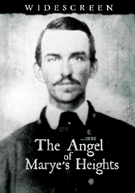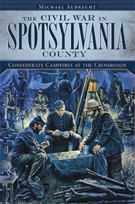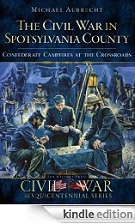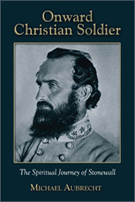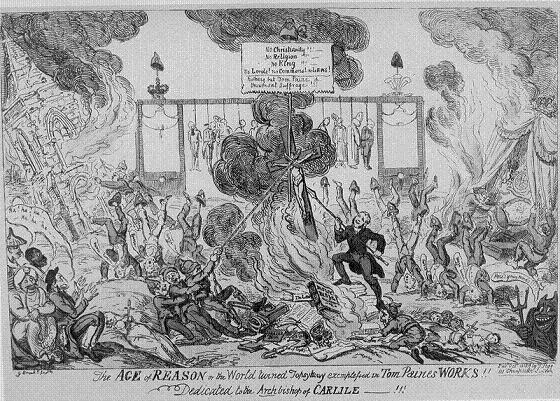
George Cruikshank cartoon attacking Thomas Paine. The caption reads:
“The Age of Reason; or, the World turned Topsy-turvy exemplified in Tom Paine’s Works!”
Often referred to as the “Father of the American Revolution,” Thomas Paine was also THE best-selling author in eighteenth-century America. Even those with a casual knowledge of our nation’s history are familiar with his most popular work titled Common Sense. This of course was the radical political-pamphlet that he anonymously published (as “an Englishman”) in January of 1776. Common Sense presented the American colonists with an argument for freedom from English rule at a time when the question of independence was still being debated. Upon its release, Common Sense quickly spread among the literate and within three months, 100,000 copies were sold throughout the colonies.
Many people forget that Thomas Paine went on to write a highly controversial deistic-pamphlet titled The Age of Reason; Being an Investigation of True and Fabulous Theology. This publication levied harsh criticism on the institution of organized religion and challenged the very legitimacy of the Christian Bible. Published in three parts over a period of three years (1794, 1795, and 1807), it was also a best-seller that ignited a short-lived deistic revival.
Much like Thomas Jefferson who wrote his own interpretation of scripture, Paine favored scientific-reason over faith and rejected all biblical references to miracles. While promoting the concept of “natural religion” he openly abandoned the notion that the Christian Bible was a divinely inspired book and argued against the very existence of a creator-God. By taking a philosophical stance that was usually reserved for the educated-elite and making it irreverent (and inexpensive), Paine was able to appeal to a mass readership, thus increasing sales while spreading his divisive message. Although (at the time) it did not sell nearly as well as Common Sense, The Age of Reason went through seventeen editions and sold thousands of copies in the United States.
Not surprising, Paine’s irreverent assumptions on organized religion (Christianity in particular) were met with much anger and outrage, especially from the Church of England. The British government reacted to this by prosecuting any printer or bookseller that tried to produce and/or distribute the book. The content of The Age of Reason was divided into three sections: In Part I, Paine outlined his major arguments and personal creed. In Parts II and III, he analyzed specific portions of the Christian Bible in order to demonstrate that it was not the revealed “Word of God.” Throughout the book Paine placed an emphasis on the individual’s right of conscience and an inherent accountability to be held to oneself. At the beginning of Part I, Paine summarized his personal creed:
I believe in one God, and no more; and I hope for happiness beyond this life.
I believe in the equality of man; and I believe that religious duties consist in doing justice, loving mercy, and endeavoring to make our fellow-creatures happy.
But, lest it should be supposed that I believe many other things in addition to these, I shall, in the progress of this work, declare the things I do not believe, and my reasons for not believing them.
I do not believe in the creed professed by the Jewish Church, by the Roman Church, by the Greek Church, by the Turkish Church, by the Protestant Church, nor by any church that I know of. My own mind is my own church.
All national institutions of churches, whether Jewish, Christian or Turkish, appear to me no other than human inventions, set up to terrify and enslave mankind, and monopolize power and profit.
I do not mean by this declaration to condemn those who believe otherwise; they have the same right to their belief as I have to mine. But it is necessary to the happiness of man that he be mentally faithful to himself. Infidelity does not consist in believing, or in disbelieving; it consists in professing to believe what he does not believe.
In his argument against the Bible, Paine not only questioned the sacredness of the text, but also its historical origins. He often referred to the stories as “fabulous mythology” and stated that the Book of Proverbs was “inferior in keenness to the proverbs of the Spaniards, and not more wise and economical than those of the American Franklin [referring to Benjamin].” Paine then went on to question the overall consistency and accuracy of the Bible, blaming the errors on man as opposed to a divine being. Many of his comparative-reasoning styles are still practiced today in biblical scholarship.
The Old Testament in particular became a major target for Paine’s criticisms. He argued that the God of the Old Testament was so tyrannical and cruel that he could only be a “human-authored-myth.” He then went on to present a series of incidents supporting this theory including an account from the Book of Numbers, specifically 31:13–47, in which Moses orders the slaughter of thousands of boys and women, as well as the abduction of virgins. Excerpt: “15 ‘Have you allowed all the women to live?’ he asked them. 16 ‘They were the ones who followed Balaam’s advice and enticed the Israelites to be unfaithful to the LORD in the Peor incident, so that a plague struck the LORD’s people. 17 Now kill all the boys. And kill every woman who has slept with a man, 18 but save for yourselves every girl who has never slept with a man.’” Paine called this kind of content a “book of lies, wickedness, and blasphemy; for what can be greater blasphemy than to ascribe the wickedness of man to the orders of the Almighty!”
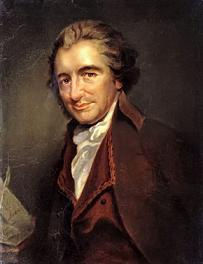 Another sentiment offered up by Paine was the distrust of religious institutions. This included the indicting of priests for their want of power and the Church’s opposition to scientific investigation. He recalled: “Soon after I had published the pamphlet ‘Common Sense,’ in America, I saw the exceeding probability that a revolution in the system of government would be followed by a revolution in the system of religion. The adulterous connection of Church and State, wherever it has taken place has so effectually prohibited by pains and penalties every discussion upon established creeds, and upon first principles of religion, that until the system of government should be changed, those subjects could not be brought fairly and openly before the world; but that whenever this should be done, a revolution in the system of religion would follow.”
Another sentiment offered up by Paine was the distrust of religious institutions. This included the indicting of priests for their want of power and the Church’s opposition to scientific investigation. He recalled: “Soon after I had published the pamphlet ‘Common Sense,’ in America, I saw the exceeding probability that a revolution in the system of government would be followed by a revolution in the system of religion. The adulterous connection of Church and State, wherever it has taken place has so effectually prohibited by pains and penalties every discussion upon established creeds, and upon first principles of religion, that until the system of government should be changed, those subjects could not be brought fairly and openly before the world; but that whenever this should be done, a revolution in the system of religion would follow.”
Over the years many historians have supported to notion that Paine’s religious and political philosophies were very much in support of one-another. Therefore Paine felt that propagating a religious revolution was crucial to the success of any political revolution, not only because the Church controlled the State, but also because it required a radically new way of thinking and looking at the world. The threat to achieving this “political enlightenment” was directly attributed to a religious superstition that prevented oneself from diversifying their antiquated perspective or rejecting what they had been taught. Scholars have referred to this theory as Paine’s “secular-millennialism.” Perhaps Paine’s most telling statement on the subject of reform (religious and otherwise) came in the conclusion to his Rights of Man when he stated: “From what we now see, nothing of reform in the political world ought to be held improbable. It is an age of revolutions, in which everything may be looked for.”
Thomas Paine’s thoughts on this world (and the next) are still debated today. In 2006, English writer and Atheist Christopher Hitchens wrote a book about the affect of Paine’s writings. In it he summarized the need for his words in today’s political spectrum. He wrote, “If the rights of man are to be upheld in a dark time, we shall require an age of reason. In a time when both rights and reason are under several kinds of open and covert attack, the life and writing of Thomas Paine will always be part of the arsenal on which we shall need to depend.”Read The Age of Reason; Being an Investigation of True and Fabulous Theology.
Updated: Friday, 20 May 2011 1:07 PM EDT
Permalink | Share This Post
